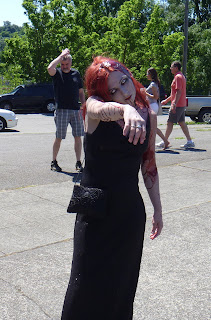I have cleverly inked out the name of the defendant and shown only part of her face, so you cannot possibly guess whom I am referring to.
At a science fiction convention, I heard two CSI speakers describe their craft in great detail. The session was packed, and we were fascinated at the techniques that can bring murderers and other criminals to justice. But one part of it was disturbing: What they call the CSI effect.
Jurors nowadays have watched television dramas like the multiple CSI series, Bones, or other shows that dramatize the use of forensic evidence gathered at crime scenes. The problem is, juries often expect that same sort of evidence when they sit in a courtroom. As these experts said, there was a case where a criminal’s presence was proved by his fingerprints. A juror voted not guilty. She reasoned that since no DNA evidence was shown, the criminal’s presence was not really proved.
These CSI type of shows have barely possible scenarios, in which they find a strand of hair, and their analysis then shows the assailant was left-handed and used a monkey wrench to kill the victim while Colonel Mustard was standing ten feet to the right. By the end of the episode, they can show by animation, holographic imagery, or blurry imagination with lots of screaming exactly how the murder took place. And jurors expect that. They want to know the exact method of the murder, at exactly what angle the victim was struck, and the exact movements of the murderer before, during, and after the act.
These expectations pretty much belong to the realm of fantasy land.
In the case I referenced, pundits on the news have said the prosecution must know the method of death in order to convict the accused mother. Not true. The standard of proving the accused guilty beyond a reasonable doubt does not include knowing the method of death. Look it up. Taken to a ridiculous extreme, you could have a videotape of the mother throwing her little girl, wrapped in blanket but with duct tape on the face, into a swamp. If you do not know if the baby died before being thrown in, you would have to find the mother not guilty, by that reasoning.
Another silly argument is that there is no DNA on the duct tape that was on the baby’s face that could link it to the mother. Again, the term DNA is not included in the concept of the prosecution having to prove a charge beyond a reasonable doubt. Such evidence helps, but is not necessary. The baby and the duct tape had been in the swamp long enough (and had probably been in the trunk of a car for a long time before then), so that no DNA could be recovered. Other reasoning comes into play. The mother did not report the child as missing for about a month. Whenever a dead child is found with duct tape over his or her mouth, it is always a homicide. No one else could have a reasonable motive for putting duct tape on the child. You do not have to have a videotape of the mother throwing the child into the swamp or DNA evidence from her on the duct tape.
The particulars of that case are more detailed, of course. But the problem is that jurors expect a mountain of forensic evidence that shows exactly how the crime occurred and showing the accused’s DNA right there at the scene. Going back to the workshop, there was one case where in previous years the defendant would have been found guilty by a typical jury. But one juror expected the whole show as far as esoteric evidence. The juror said that since the prosecution did not present such evidence, they must have known the accused was not really guilty.
The standard is that an ordinary person using common sense must find the accused guilty beyond a reasonable doubt. The doubt must be reasonable, not just any possible scenario. Circumstantial evidence has the same weight in court as direct evidence. The incredible evidence that CSI teams can produce is a help, but not always necessary. Jurors are expecting court cases to look like TV shows. I have been on jury duty at least six times, possibly more. The real system of justice does not look like a TV show.








